Is there any way to stop this blurring when scaling a Canvas? I presume it's related to GPU interpolation. But what I need is a pixel-perfect "pixelated" zoom here. Just use the color of the nearest "real" neighboring pixel.
I've seen the solutions here but of the two suggested that work (#1 / #4), #4 is definitely CPU scaling and #1 I guess is too.
This scaling needs to be FAST - I'd like to be able to support up to maybe 20-25 layers (probably Canvases in a StackPane but I'm open to other ideas as long as they don't melt the CPU). I'm having doubts this can be done without GPU support which JFX offers, but maybe not with a flexible enough API. Strategies like #4 in the linked answer which rely on CPU rescaling probably aren't going to work.
If you zoom into the highest zoom level with this code the blurring is obvious.
Do we need an update to the JFX API to support this or something? This should be possible to do.
import javafx.application.Application;
import javafx.beans.property.IntegerProperty;
import javafx.beans.property.SimpleIntegerProperty;
import javafx.scene.Scene;
import javafx.scene.canvas.Canvas;
import javafx.scene.control.Button;
import javafx.scene.control.Label;
import javafx.scene.layout.Pane;
import javafx.scene.layout.StackPane;
import javafx.scene.paint.Paint;
import javafx.stage.Stage;
public class ScaleTest extends Application {
private static final int width = 1200;
private static final int height = 800;
private static final int topMargin = 32;
private StackPane stackPane;
private IntegerProperty zoomLevel = new SimpleIntegerProperty(100);
@Override
public void start(Stage stage) {
stage.setWidth(width);
stage.setMinHeight(height);
stackPane = new StackPane();
stackPane.setLayoutY(topMargin);
Canvas canvas = new Canvas(width, height - topMargin);
Label label = new Label();
label.setLayoutY(2);
label.setLayoutX(2);
label.setStyle("-fx-text-fill: #FFFFFF");
label.textProperty().bind(zoomLevel.asString());
Button zoomInBtn = new Button("Zoom In");
zoomInBtn.setLayoutY(2);
zoomInBtn.setLayoutX(50);
zoomInBtn.onActionProperty().set((e) -> {
if (zoomLevel.get() < 3200) {
zoomLevel.set(zoomLevel.get() * 2);
stackPane.setScaleX(zoomLevel.get() / 100.0);
stackPane.setScaleY(zoomLevel.get() / 100.0);
}
});
Button zoomOutBtn = new Button("Zoom Out");
zoomOutBtn.setLayoutY(2);
zoomOutBtn.setLayoutX(140);
zoomOutBtn.onActionProperty().set((e) -> {
if (zoomLevel.get() > 25) {
zoomLevel.set(zoomLevel.get() / 2);
stackPane.setScaleX(zoomLevel.get() / 100.0);
stackPane.setScaleY(zoomLevel.get() / 100.0);
}
});
Pane mainPane = new Pane(stackPane, label, zoomInBtn, zoomOutBtn);
mainPane.setStyle("-fx-background-color: #000000");
Scene scene = new Scene(mainPane);
stage.setScene(scene);
drawGrid(canvas, 0, 0, width, height - topMargin, 16);
stackPane.getChildren().add(canvas);
stage.show();
}
private void drawGrid(Canvas canvas, int xPos, int yPos, int width, int height, int gridSize) {
boolean darkX = true;
String darkCol = "#111111";
String lightCol = "#222266";
for (int x = xPos; x < canvas.getWidth(); x += gridSize) {
boolean dark = darkX;
darkX = !darkX;
if (x > width) {
break;
}
for (int y = yPos; y < canvas.getHeight(); y += gridSize) {
if (y > height) {
break;
}
dark = !dark;
String color;
if (dark) {
color = darkCol;
} else {
color = lightCol;
}
canvas.getGraphicsContext2D().setFill(Paint.valueOf(color));
canvas.getGraphicsContext2D().fillRect(x, y, gridSize, gridSize);
}
}
}
}
